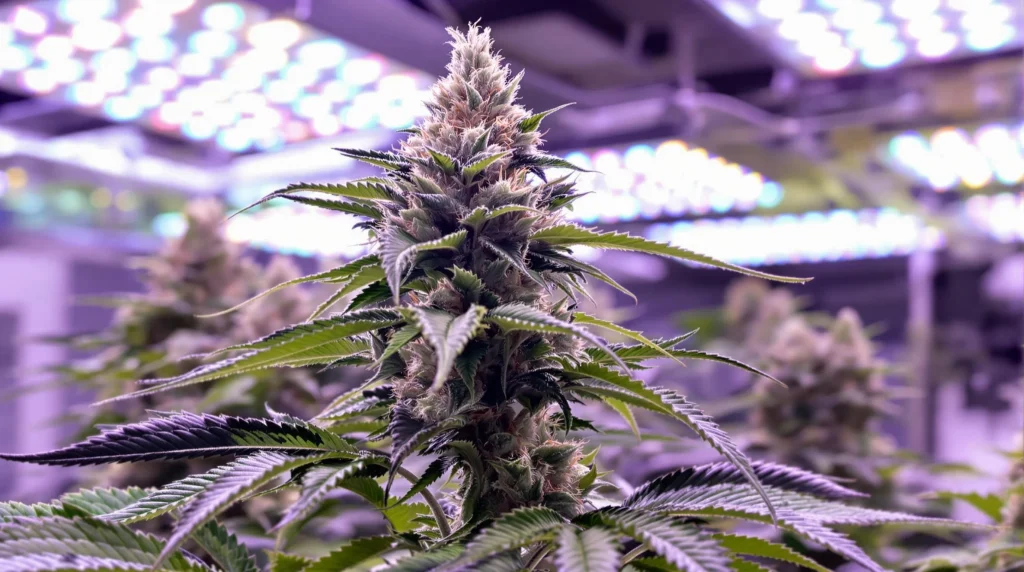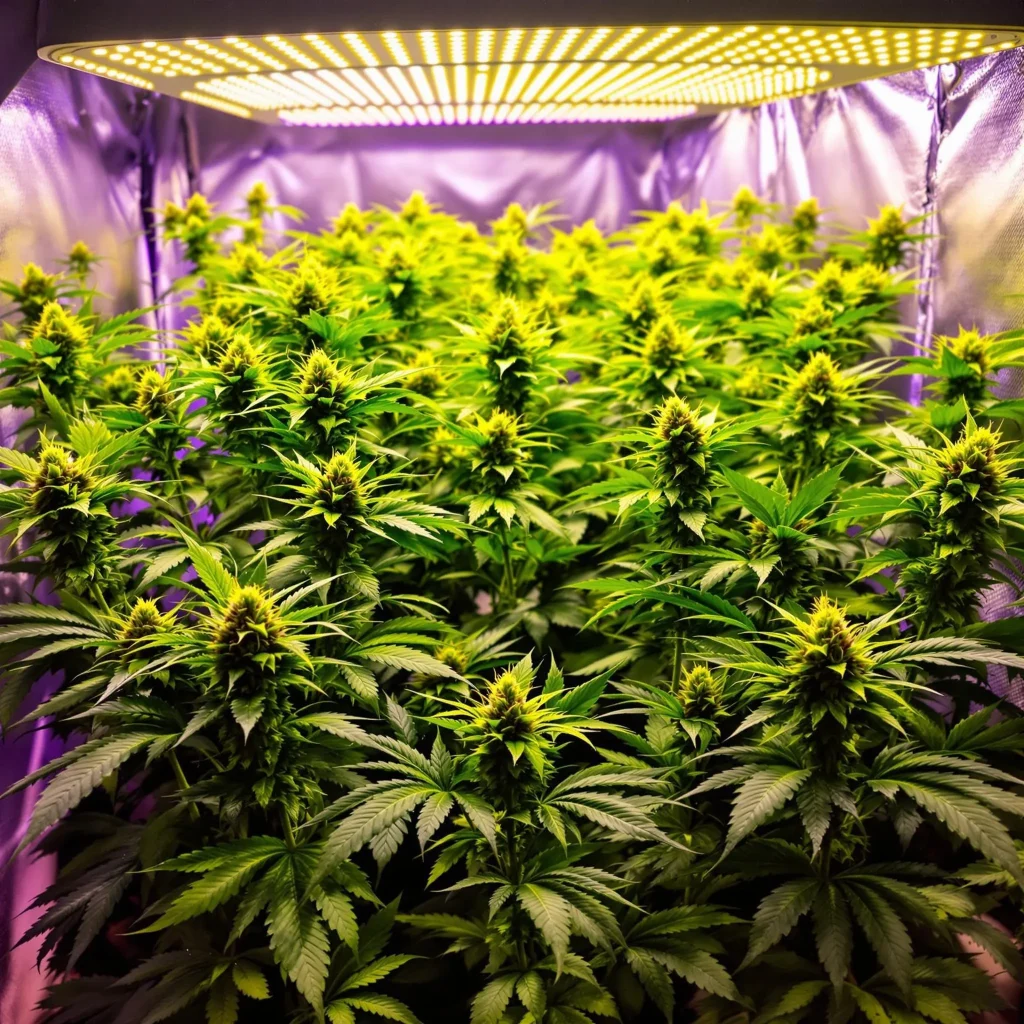When it comes to cultivating autoflowers, many growers wonder if using a 24-hour light cycle is the secret to maximum growth and yield. Autoflowering cannabis strains are unique in their ability to thrive without relying on seasonal light changes, making them a popular choice for growers seeking efficiency and reliability. But are all strains suited for nonstop light? Let’s dive into the best autoflower strains and techniques for a 24-hour light cycle.
What Is a 24-Hour Light Cycle for Autoflowers?
Autoflowers and Light Cycles
Autoflowers differ from photoperiod strains because they don’t need a specific light cycle to flower. Instead, their growth is time-dependent, making them adaptable to continuous light schedules. A 24-hour light cycle means keeping your grow lights on around the clock, providing uninterrupted light exposure to your plants.
This method is designed to maximize photosynthesis and growth. Autoflowers can handle the constant light because of their hardiness, but some strains perform better than others under these conditions. Using a proper autoflower 24 hour light setup ensures optimal growth.
Why Use 24-Hour Light for Autoflowers?
Continuous light can lead to faster growth and potentially higher yields. Without a dark period, your plants spend more time in photosynthesis, generating energy for growth and bud development. This method can also help maintain consistent temperatures in your grow space, reducing stress on your plants.
However, not all strains are equally suited to this intense schedule. Selecting autoflower strains bred for robustness is critical to success under a autoflower 24 hour light cycle.

Best Autoflower Strains for 24-Hour Light
1. Gorilla Glue Auto
Gorilla Glue Auto is known for its resilience and adaptability, making it a top choice for continuous light. This strain delivers dense buds packed with potency, ideal for growers seeking strong effects and high THC levels.
Under a autoflower 24 hour light cycle, Gorilla Glue Auto thrives by using the constant energy for rapid vegetative growth and prolific flowering. Its ability to handle stress makes it a standout performer in nonstop light setups.
2. Northern Lights Auto
Northern Lights Auto is a classic strain that remains a favorite for its forgiving nature and strong genetics. With a sweet and earthy aroma, this strain produces compact, resinous buds that are perfect for indoor grows.
The consistent energy from autoflower 24 hour light enhances its yield potential, allowing growers to capitalize on its robust nature. Northern Lights Auto is an excellent option for beginners and experienced growers alike.
3. Amnesia Haze Auto
For those seeking a sativa-dominant strain, Amnesia Haze Auto offers uplifting effects and impressive yields. This strain requires consistent energy to fuel its taller growth structure and extended flowering period.
Using a autoflower 24 hour light cycle with Amnesia Haze Auto ensures vigorous growth and plentiful bud production, making it a fantastic option for high-energy grows.
Benefits and Drawbacks of 24-Hour Light Cycles
Advantages of 24-Hour Light
- Maximized growth due to uninterrupted photosynthesis.
- Simplified temperature control in grow spaces.
- Higher yields from consistent energy availability.
Challenges of 24-Hour Light
- Increased energy costs due to continuous light use.
- Potential plant stress in less resilient strains.
- Heat management challenges requiring ventilation.
Knowing the benefits and drawbacks ensures you can optimize your autoflower 24 hour light setup.
How to Set Up a 24-Hour Light Cycle
Selecting the Right Grow Lights
Choosing the right grow lights is critical for a successful 24-hour light cycle. LED lights are the top choice for this setup due to their energy efficiency, low heat output, and ability to provide a full spectrum of light. They are cost-effective in the long term and reduce the need for excessive cooling systems.
HID (High-Intensity Discharge) lights and CFL (Compact Fluorescent Lights) can also be used, but they come with drawbacks. HID lights are powerful but generate significant heat, which can stress plants and increase the need for ventilation. CFLs are budget-friendly and suitable for smaller grows, but they lack the intensity and coverage needed for larger operations. Opting for LEDs ensures consistent light intensity, lower electricity bills, and healthier plant development throughout the grow cycle.
Optimizing Your Grow Environment
Creating a stable environment is key for an autoflower 24-hour light grow room. Start by installing a reliable ventilation system with fans and exhausts to manage heat and ensure fresh air circulation. This prevents the buildup of excess heat and humidity, both of which can negatively impact plant health.
Maintain ideal humidity levels, around 40–60% depending on the growth stage, and monitor temperature consistently. Temperatures should stay between 70–85°F (21–29°C). Use a hygrometer and thermometer to keep these parameters in check. Additionally, regularly inspect your plants for signs of stress, such as leaf curling, drooping, or discoloration. Adjust airflow, lighting, or watering schedules as necessary to maintain optimal conditions for your autoflowers.
Feeding and Watering Under Continuous Light
Increased Nutritional Demands
Under a 24-hour light cycle, autoflowers grow at an accelerated rate, which means their nutritional needs increase significantly. Provide a balanced nutrient solution rich in nitrogen during the vegetative phase and transition to phosphorus and potassium-heavy formulas during flowering. Regularly check the pH levels of your nutrient solution, aiming for a range of 6.0–7.0 for soil and 5.5–6.5 for hydroponics to ensure proper nutrient absorption.
To prevent overfeeding, observe your plants for signs of nutrient burn, such as browning leaf tips, and adjust your feeding schedule accordingly. Incorporating beneficial additives like calcium, magnesium, and amino acids can further enhance plant health and yield under continuous lighting.
Watering Techniques
Constant light exposure can cause your plants to consume water at a faster rate. Check soil moisture frequently and water your plants only when the top inch of soil feels dry. Overwatering can lead to root rot, especially in the high-humidity conditions of a 24-hour light cycle. For hydroponic systems, maintain consistent water levels and aeration to support healthy root development.
Using automated watering systems can help ensure consistency, especially for growers managing multiple plants. Additionally, introducing mycorrhizal fungi or other beneficial microbes can improve root health and nutrient uptake, maximizing the benefits of the 24-hour light cycle.

Alternative Light Cycles for Autoflowers
20/4 Light Cycle
The 20/4 light cycle provides 20 hours of light and 4 hours of darkness each day, striking a balance between growth and energy efficiency. This cycle allows plants to rest while still receiving ample light for photosynthesis and development. Many growers find this option effective for maintaining robust growth without the higher energy demands of a 24-hour cycle.
Using a 20/4 cycle is a reliable alternative to the autoflower 24-hour light method. It’s particularly beneficial for growers aiming to cut costs on electricity while still supporting vigorous plant development and solid yields.
18/6 Light Cycle
An 18/6 cycle offers 18 hours of light and 6 hours of darkness daily, mimicking natural daylight hours more closely than other cycles. This schedule is ideal for growers who prefer a traditional approach while maintaining healthy growth rates. Although the yields might be slightly lower than with continuous light, the reduced energy consumption makes it a popular choice.
For growers who notice light stress in their plants, transitioning to an 18/6 light cycle can alleviate stress without significantly compromising yields, making it a versatile option for autoflower cultivation.
16/8 Light Cycle
The 16/8 cycle provides 16 hours of light and 8 hours of darkness. It’s suitable for strains that show sensitivity to prolonged light exposure or for growers in warmer climates who need to manage heat more effectively. This light cycle promotes steady growth while reducing electricity usage and giving plants a longer rest period.
Although yields may not be as high as with 20/4 or 24-hour cycles, a 16/8 cycle is an excellent choice for growers prioritizing cost savings and plant health.
Tips for Growing Autoflowers Under 24-Hour Light
Choose Resilient Strains
Selecting autoflower strains known for their resilience is crucial for success in a 24-hour light setup. Strains like Gorilla Glue Auto, Northern Lights Auto, and Amnesia Haze Auto are particularly well-suited for this light cycle due to their ability to thrive under constant lighting.
Resilient strains are ideal for both beginners and experienced growers, as they are more forgiving of environmental fluctuations and nutrient changes while delivering impressive yields.
Monitor Your Plants Regularly
Under continuous light, regular monitoring is essential to identify and address any issues early. Look for signs of stress, such as curling leaves, discoloration, or slowed growth. Adjust feeding schedules, watering frequency, or light intensity as needed to maintain optimal conditions.
Invest in Quality Equipment
High-quality grow equipment is non-negotiable for a successful 24-hour light cycle. Use energy-efficient LED grow lights to minimize electricity costs and heat output. Additionally, invest in reliable ventilation systems and monitoring tools to maintain a stable environment.
Quality equipment not only improves plant health but also ensures long-term success by reducing the risks associated with overheating, nutrient deficiencies, or light stress.
Maintaining Plant Health in a 24-Hour Light Cycle
Preventing Light Stress
Although autoflowers are generally resilient, continuous exposure to intense light can lead to stress. Symptoms of light stress include leaf curling, discoloration, and slowed growth. Mitigate these issues by raising the grow lights or reducing their intensity if signs of stress appear.
Regularly inspect your plants to ensure they thrive under autoflower 24-hour light conditions. Prompt adjustments to the environment help maintain health and prevent long-term damage.
Humidity and Temperature Control
Maintaining optimal humidity and temperature levels is critical under a 24-hour light cycle. High humidity combined with constant lighting can encourage mold and mildew growth, while excessive heat can stunt plant development. Use dehumidifiers and fans to regulate humidity, keeping it between 40–60%, depending on the plant’s growth stage.
Temperatures should remain stable, ideally between 70–85°F. Monitoring and controlling these factors ensures your autoflowers grow in an environment conducive to robust development and high yields.
Nutrient Management
Under constant light, autoflowers consume more nutrients to sustain their accelerated growth. Provide a balanced feeding schedule that aligns with their specific growth phase. Use nitrogen-rich fertilizers during the vegetative stage and switch to phosphorus and potassium-dominant nutrients during flowering.
Incorporating Defoliation Practices
Defoliation and topping are advanced techniques that can enhance airflow and light penetration. During the later flowering stages, selective defoliation removes excess foliage, allowing light to reach lower buds and improving overall yield quality. Similarly, topping early in the vegetative stage encourages bushier growth and maximizes light distribution.
While these methods are beneficial, they require precise timing and execution. Over-defoliating or improper topping can stress plants, especially under continuous light.
FAQs About Autoflower 24 Hour Light
Is a 24-hour light cycle safe for all autoflowers?
While most autoflower strains are bred to thrive under continuous light, not all of them handle the 24-hour cycle equally well. Some sensitive strains may display symptoms like slowed growth, leaf curling, or discoloration when exposed to prolonged light intensity. Choosing robust, stress-resistant strains like Amnesia Haze Auto or Northern Lights Auto ensures better adaptability to this setup.
Does 24-hour light increase yields?
How much does 24-hour light cost?
The cost of running a 24-hour light cycle depends on your grow setup, the efficiency of your lighting system, and local electricity rates. For example, using traditional HID or CFL lights can lead to significant energy costs due to their high power consumption and heat output. In contrast, energy-efficient LED grow lights can substantially reduce expenses while maintaining excellent light quality.
Can 24-hour light harm my plants?
Although autoflowers are known for their resilience, prolonged exposure to intense light can still cause stress, even in these hardy strains. Light stress may manifest as curling leaves, discoloration, slowed growth, or even bleaching of the foliage if light intensity is too high or the grow lights are placed too close to the plants.

